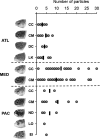Microplastic ingestion ubiquitous in marine turtles
- PMID: 30513551
- PMCID: PMC6849705
- DOI: 10.1111/gcb.14519
Microplastic ingestion ubiquitous in marine turtles
Abstract
Despite concerns regarding the environmental impacts of microplastics, knowledge of the incidence and levels of synthetic particles in large marine vertebrates is lacking. Here, we utilize an optimized enzymatic digestion methodology, previously developed for zooplankton, to explore whether synthetic particles could be isolated from marine turtle ingesta. We report the presence of synthetic particles in every turtle subjected to investigation (n = 102) which included individuals from all seven species of marine turtle, sampled from three ocean basins (Atlantic [ATL]: n = 30, four species; Mediterranean (MED): n = 56, two species; Pacific (PAC): n = 16, five species). Most particles (n = 811) were fibres (ATL: 77.1% MED: 85.3% PAC: 64.8%) with blue and black being the dominant colours. In lesser quantities were fragments (ATL: 22.9%: MED: 14.7% PAC: 20.2%) and microbeads (4.8%; PAC only; to our knowledge the first isolation of microbeads from marine megavertebrates). Fourier transform infrared spectroscopy (FT-IR) of a subsample of particles (n = 169) showed a range of synthetic materials such as elastomers (MED: 61.2%; PAC: 3.4%), thermoplastics (ATL: 36.8%: MED: 20.7% PAC: 27.7%) and synthetic regenerated cellulosic fibres (SRCF; ATL: 63.2%: MED: 5.8% PAC: 68.9%). Synthetic particles being isolated from species occupying different trophic levels suggest the possibility of multiple ingestion pathways. These include exposure from polluted seawater and sediments and/or additional trophic transfer from contaminated prey/forage items. We assess the likelihood that microplastic ingestion presents a significant conservation problem at current levels compared to other anthropogenic threats.
Keywords: anthropogenic debris; marine debris; marine plastic; marine turtle; microplastics; plastic pollution.
© 2018 The Authors. Global Change Biology Published by John Wiley & Sons Ltd.
Figures



References
-
- Baird, C. A. (2016). Measuring the effects of microplastics on sponges. Wellington, New Zealand: Victoria Univeristy of Wellington.
-
- Bell, I. (2013). Algivory in hawksbill turtles: Eretmochelys imbricata food selection within a foraging area on the Northern Great Barrier Reef. Marine Ecology, 34, 43–55. 10.1111/j.1439-0485.2012.00522.x - DOI
-
- Bjorndal, K. A. (1980). Nutrition and grazing behavior of the green turtle Chelonia mydas . Marine Biology, 56, 147–154. 10.1007/BF00397131 - DOI
Publication types
MeSH terms
Substances
LinkOut - more resources
Full Text Sources

